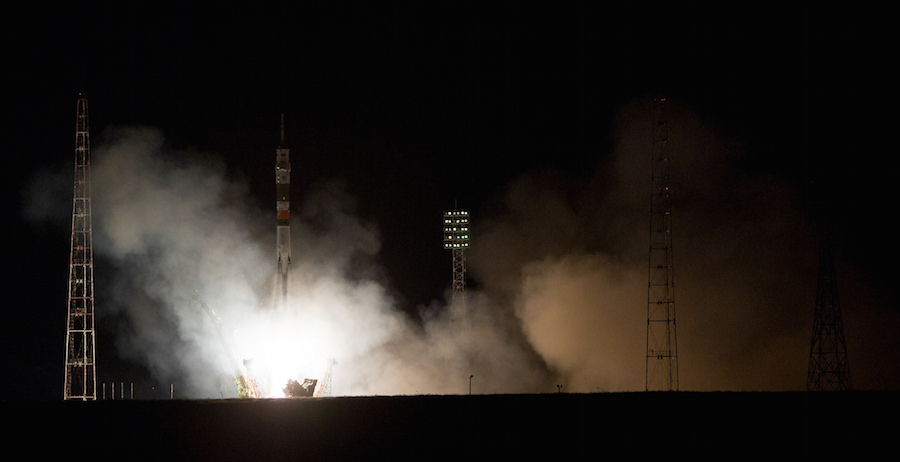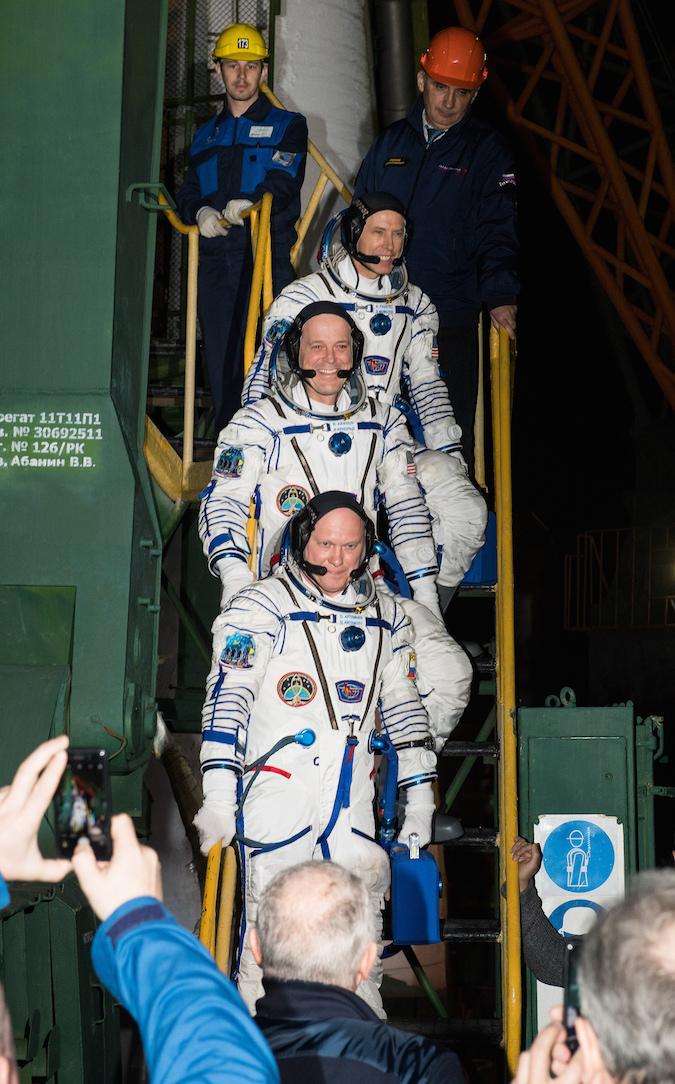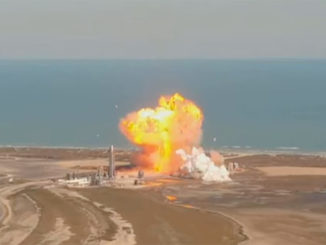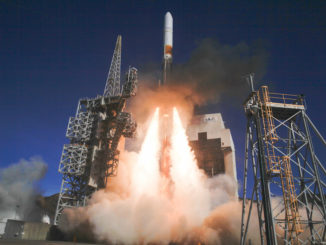STORY WRITTEN FOR CBS NEWS & USED WITH PERMISSION

A Russian Soyuz rocket blasted off and shot into orbit Wednesday, carrying a Russian cosmonaut and two NASA astronauts, all veteran space fliers, on a two-day flight to the International Space Station.
With Soyuz MS-08/54S commander Oleg Artemyev at the controls in the spacecraft’s center seat, flanked on the left by flight engineer Drew Feustel and on the right by Ricky Arnold, the workhorse booster’s main engines ignited with a crackling roar at 1:44 p.m. EDT (GMT-4; 11:44 p.m. local time) and quickly throttled up to full thrust.
After last-second checks, the booster was released from its firing stand and the rocket climbed away into a clear, night sky atop a brilliant jet of flaming exhaust. Launching directly into the plane of the space station’s orbit, the rocket arced away to the east and slowly faded from view as it accelerated toward space.
After helping push the rocket out of the thick lower atmosphere, the Soyuz FG’s four liquid-fueled strap-on boosters fell away as planned about two minutes after liftoff and the flight continued on the power of the rocket’s central core and upper stage.
Live television views from inside the central command module showed Artemyev calmly monitoring cockpit displays while Feustel and Arnold followed along, all three looking relaxed.
“Everything is fine on board,” Artemyev reported. “We’re doing excellent.” Toward the end of the climb to space, he added “the crew’s mood is festive.”
Finally, eight minutes and 45 seconds after launch, the third stage engine shut down and the Soyuz MS-08 spacecraft was released to fly on its own. A few moments after that, its solar arrays and navigation antennas deployed and Russian flight controllers reported the Soyuz was healthy and in good shape to press ahead with the planned two-day rendezvous.
At the moment of launch, the space station was 261 miles above the south Atlantic Ocean, east of Argentina and heading toward Baikonur. Launching into the same orbital plane as the station, the Soyuz crew will carry out a series of carefully choreographed thruster firings to adjust the altitude — and velocity — as required to catch up with the space station Friday afternoon.
If all goes well, Artemyev and Feustel will monitor an automated approach to the lab complex, moving in for docking at the upper Poisk module around 3:41 p.m. Friday. After hooks and latches engage to firmly lock the ferry ship in place, the crew will stand by for extensive leak checks to verify an airtight, structurally sound seal.
Once that seal is verified, Expedition 55 commander Anton Shkaplerov, NASA astronaut Scott Tingle and Japanese crewmate Norishige Kanai will welcome their new crewmates aboard. They’ve had the station to themselves since three other crew members — Alexander Misurkin, Mark Vande Hei and Joe Acaba — returned to Earth on Feb. 27 to close out a 168-day stay in space.
Artemyev, Feustel and Arnold, all three spaceflight — and spacewalk — veterans bring a wealth of experience to the station.

Artemyev completed a 169-day stay aboard the station in 2014, participating in two spacewalks totaling 12 hours and 34 minutes. Arnold, an educator with a degree in marine science who has taught at schools around the world, flew a single mission aboard the shuttle Discovery in 2009 and logged two spacewalks totaling 12 hours 34 minutes helping install one of the station’s main solar array truss segments.
Feustel participated in two shuttle missions for a combined 28 days 15 hours in space, one in 2009 to service the Hubble Space Telescope and another in 2011 to help finish construction of the space station.
He logged 21 hours and 20 minutes of EVA time during three excursions at the space station and another 20 hours and 58 minutes during three spacewalks to work on the Hubble telescope.
Feustel and Arnold expect to venture outside the space station on March 29 to install wireless communications gear that will be used by an external payload and, eventually, by approaching commercial crew ferry ships being built by Boeing and SpaceX. They also plan to swap out a high-definition camera and remove aging hoses in the station’s ammonia coolant system.
Two more NASA spacewalks are expected in the May-June timeframe, followed by a Russian excursion in August. But the primary goal of the mission is science, with a full agenda of experiments and research on tap, along with the usual station maintenance work.
“As you know, we’re the hands, eyes and ears of the researchers, and our job is just to keep things operating and executing the science,” Feustel said before launch. “Most of us don’t make up science experiments to take to space, but we’re really there to make sure everything gets done to ensure the success of the mission.
“I’m a bit of a gearhead, so putting my hands on the hardware to make sure we can keep it operating will be a fun challenge.”
Shkaplerov, Tingle and Kanai are scheduled to return to Earth on June 3 to close out a 167-day voyage. Artemyev, Feustel and Arnold expect to remain in space for 159 days, returning to a landing on the steppe of Kazakhstan on Aug. 28.
“Take care of space station for us,” Bill Gerstenmaier, director of spaceflight at NASA Headquarters, told the Artemyev crew before launch. “You’ll have a great time.”



